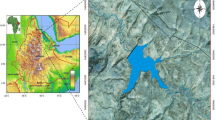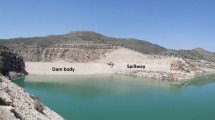Abstract
It is proposed to construct a dam across the Geba River, Ethiopia. The paper reports the engineering geological investigations undertaken, including mapping, discontinuity surveys, core drilling, water absorption testing and sampling for laboratory tests. The complexity of the site, with limestones and interbedded limestone-shale horizons, is indicated by the variability of the RQD and Lugeon values. Of the 63 tests undertaken, some two-thirds had Lugeon values implying grouting was necessary. Following removal and replacement of the alluvial deposits in the central area, a grout curtain including two to three rows of grouting holes was recommended to a depth of 100 m for the left abutment, 35 m for the central foundation and 60 m for the right abutment.
Résumé
La construction d’un barrage sur le fleuve Geba, en Ethiopie, est projetée. L’article présente les reconnaissances géologiques et géotechniques réalisées, comprenant une cartographie, des levers de discontinuités, des carottages, des essais d’absorption d’eau et des échantillonnages pour les essais de laboratoire. La complexité du site, avec des formations calcaires et des alternances de schistes et calcaires, se traduit par des valeurs de RQD et des résultats d’essais Lugeon très divers. Sur les 63 essais Lugeon réalisés, environ les deux tiers présentent des valeurs impliquant des travaux d’injection. Après l’enlèvement et le remplacement des dépôts alluviaux dans la zone centrale de la fondation, un écran d’injection constitué de deux à trois rangées de forages d’injection a été recommandé jusqu’à une profondeur de 100 m pour l’appui de rive gauche, 35 m pour la partie centrale de la fondation et 60 m pour l’appui de rive droite.










Similar content being viewed by others
References
Abdulkadir M (2009) Assessment of micro-dam irrigation projects and runoff predictions for ungauged catchments in northern Ethiopia. PhD dissertation, Muenster University, Germany
Angulo B, Morales T, Uriarte JA, Antigüedad A (2011) Hydraulic conductivity characterization of a karst recharge area using water injection tests and electrical resistivity logging. Eng Geol 117:90–96
Berhane G (2010a) Geological, geophysical and engineering geological investigation of a leaky micro-dam in the northern Ethiopia. Agric Eng Int CIGR J 12(1):31–46
Berhane G (2010b) Engineering geological soil and rock characterization in the Mekelle town, northern Ethiopia: implications to engineering practice. Momona Ethiop J Sci 2(2):64–86
Berhane G, Ayenew T (2010) Soil and rock characterization in the Mekele area, northern Ethiopia. Int J Earth Sci Eng 3(6):762–774
Beyth M (1971) The geology of central and western Tigray. Unpublished report, Ethiopian Institute of Geological Survey (EIGS), Addis Ababa
Beyth M (1972) Paleozoic sedimentary basin of Mekelle Outlier, northern Ethiopia. Am Assoc Pet Geol Bull 56:2426–2439
Bonacci O, Roje-Bonacci T (2008) Water losses from the Ricice reservoir built in the Dinaric karst. Eng Geol 99:121–127
Bosellini A, Russo A, Fantozzi PL, Assefa G, Tadesse S (1997) The Mesozoic succession of the Mekelle Outlier (Tigrai Province, Ethiopia). Mem Sci Geol 49:95–116
Camilo Quinones-Rozo PE (2010) Lugeon test interpretation, revisited. In: Proceedings of the 30th annual USSD conference Sacramento, California, 12–16 Apr 2010, pp 405–414
Deere DU (1964) Technical description of cores for engineering purposes. Rock Mech Eng Geol 1:18–22
Deere DU, Deere DW (1988) The rock quality designation (RQD) index in practice. In: Kirakaldie L (ed) Rock Classification systems for engineering purposes. ASTM special publication 984. American Society for Testing Materials, Philadelphia, pp 91–101
Desta LT (2005) Reservoir siltation in Ethiopia: causes, source areas and management options. PhD dissertation, University of Bonn, Germany
Ez Eldin MAM, Huiming T, Bahwi NH, Faraw AG (2007) Geological, soil and rock mass evaluation for proposed hydroelectric power plant at Sennar Dam, Sudan. J Appl Sci 7(22):3477–3484
Foyo A, Tomillo C, Maycotte JI, Willis P (1997) Geological features, permeability and groutability characteristics of the Zimapan Dam foundation, Hidalgo State, Mexico. Eng Geol 46(2):157–174
Foyo A, Sanchez MA, Tomillo C (2005) A proposal for a Secondary Permeability Index obtained from water pressure tests in dam foundations. Eng Geol 77:69–82
Ghafoori M, Lashkaripour GR, Tarigh Azali S (2011) Investigation of the geological and geotechnical characteristics of Daroongar dam, Northeast Iran. Geotech Geol Eng 29:961–975. doi:10.1007/s10706-011-9429-6
Ghazifard A, Heidari E, Hashemi M, Hangara A (2006) Evaluation of engineering geological characteristics for the Kuhrang III dam site, Iran. In: 10th IAEG international congress, 6–10 Sept 2006, Nottingham, United Kingdom
Gonzalez-Quijano M (2006) Groundwater modelling of the Tsinkanet catchment: a MODFLOW approach to evaluate the impact of small reservoirs on groundwater recharge. M.Sc. thesis, University of Ghent and University of Brussels, Belgium
Goodman R, Moye D, Shalkwyk A, Javandel I (1965) Groundwater inflow during tunnel driving. Bull Assoc Eng Geol 2:39–56
Gunay G, Milanovic P (2005) Karst engineering studies at the Akkopru reservoir area, SW of Turkey. In: Proceedings of the international conference and field seminars “water resources and environmental problems in Karst”, Belgrade and Kotor, Serbia and Montenegro, pp 651–658
Gurocak Z, Alemdag S (2011) Assessment of permeability and injection depth at the Atasu dam site (Turkey) based on experimental and numerical analyses. Bull Eng Geol Environ. doi:10.1007/s10064-011-0400-9
Hamm SY, Kim M, Cheong JY, Kim JY, Son M, Kim TW (2007) Relationship between hydraulic conductivity and fracture properties estimated from packer tests and borehole data in a fractured granite. Eng Geol 92:73–87
Haregeweyn N, Poesen J, Nyssen J, Verstraeten G, de Vente J, Govers G, Deckers S, Moeyersons J (2005) Specific sediment yield in Tigray-northern Ethiopia: assessment and semi-quantitative modelling. Geomorphology 69:315–331
Heuer R (1995) A quantitative, empirical and theoretical approach on water flow into tunnels. In: Rapid excavation and tunneling conference, San Francisco, CA, 18–21 June
Houlsby AC (1976) Routine interpretation of the Lugeon water test. Q J Eng Geol 9:303–313
Houlsby AC (1990) Construction and design of cement grouting: a guide to grouting in rock foundation. Wiley, New Jersey
ISRM (1981) Suggested methods for the quantitative description of discontinuities in rock masses. In: Barton N (ed) Rock characterization, testing and monitoring. Pergamon, Oxford
Izharul H, Hashmi FAS (1983) Permeability tests at the Simly Dam Project. Bull Eng Geol Environ 26–27(1):433–438
Kiraly L (1969) Anisotropy and heterogeneity of permeability in fractured limestones. Eclogae Geol Helv 62(2):613–619
Kiraly L (1978) Definition of the hydrogeological unit. Bull Cent Hydrogeol 2:83–216
Koutsoyiannis D (2011) Scale of water resources development and sustainability: small is beautiful, large is great. Hydrol Sci J 56(4):553–575
Lee CH, Farmer I (1993) Fluid flow in discontinuous rocks. Chapman & Hall, New York
Lee EJ, Schwab KJ (2005) Drinking water distribution systems in developing countries. J Water Health 3(2):109–127
Levitte D (1970) The geology of Mekele (report on the geology of the central part of sheet ND 37–11). Geological Survey of Ethiopia, Addis Ababa
Lugeon M (1933) Barrages et Geologie. Dunod, Paris
Mengesha T, Tadiwos C, Workineh H (1996) Explanation of the geological map of Ethiopia, scale 1:2,000,000. Ethiopian Institute of Geological Surveys Bull. No. 3
Mollah MA, Sayed SAS (1995) Assessment of in situ permeability with emphasis on packer testing in Kuwait. Eng Geol 39:217–231
Morrow CA (2000) Permeability of deep drillhole core samples. In: Proceedings of the international workshop on the Nojima fault core and Borehole analysis, USGS
Mozafari M, Raeisi E, Zare M (2011) Water leakage paths in the Doosti Dam, Turkmenistan and Iran. Environ Earth Sci. doi:10.1007/s12665-011-1069-x
Nappi M, Esposito L, Piscopo V, Rega G (2005) Hydraulic characterization of some arenaceous rocks of Molise (Southern Italy) through outcropping measurements and Lugeon tests. Eng Geol 81:54–64
Nedaw D, Walraevens K (2009) The positive effect of micro-dams for groundwater enhancement: a case study around Tsinkanet and Rubafeleg area, Tigray, northern Ethiopia. Momona Ethiop J Sci 1(1):59–73
Nonveiller E (1989) Grouting theory and practice. Elsevier, Amsterdam
Ozsan A, Akin M (2002) Engineering geological assessment of the proposed Urus Dam, Turkey. Eng Geol 66:271–281
Ozsan A, Karpuz C (1996) Geotechnical rock-mass evaluation of the Anamur dam site, Turkey. Eng Geol 42:65–70
Rockware (2010) Rockworks15 manual, 3rd edn. Rockware, Inc., USA
Sharghi Y, Siahkoohi H, Alinia F, Moarefvan P (2010) Estimation of Lugeon number at the abutments of Bakhtyari dam site using seismic tomography. Aust J Basic Appl Sci 4(2):274–285
Snow DT (1968) Rock fracture spacing, openings and porosities. J Soil Mech Found Eng 94(1):73–92
United Nations Environment Programme (2002) Vital water graphics: an overview of the state of the world’s fresh and marine waters. United Nations, Nairobi
United Nations Population Division (2002) World urbanization prospects: the 2001 revision. United Nations, New York
United Nations Population Division (2010) World urbanization prospects: the 2009 revision. United Nations, New York
Uromeihy A, Farrokhi R (2011) Evaluating groutability at the Kamal-Saleh Dam based on Lugeon tests. Bull Eng Geol Environ. doi:10.1007/s10064-011-0382-7
Walraevens K, Vandecasteele I, Martens K, Nyssen J, Moeyersons J, Gebreyohannes T, De Smedt F, Poesen J, Deckers J, Van Camp M (2009) Groundwater recharge and flow in a small mountain catchment in northern Ethiopia. Hydrol Sci J 54(4):739–753
Wolela A (2008) Sedimentation of the Triassic–Jurassic Adigrat Sandstone Formation, Blue Nile (Abay) Basin, Ethiopia. J Afr Earth Sci 52:30–42
WWDSE (2007) Evaluation of Aynalem wellfield and selection of prospective well fields around Mekelle Town for water supply source. Unpublished technical report, Addis Ababa
Yamaguchi Y, Shibuichi H, Matsumoto N (1997) Permeability evaluation of jointed rock masses using high viscosity fluid tests. Int J Rock Mech Min Sci 34:344.e1–344.e15
Acknowledgments
The authors are very grateful to the Department of Earth Science of Mekelle University for providing logistic support to conduct the fieldwork. Thanks also to the Flemish Interuniversity Council—University Cooperation for Development (VLIR-UOS) for the short research stay grant at Ghent University, Belgium, which allowed the first author to prepare this article. We appreciate the data provided by the Tigray Water Resource, Mines and Energy Bureau and Addis Geosystems PLC and the opportunity given to the first author to work with them during the investigation program. Thanks are also given to the staff at the Laboratory for Applied Geology and Hydrogeology of Ghent University for their assistance during the work.
Author information
Authors and Affiliations
Corresponding author
Rights and permissions
About this article
Cite this article
Berhane, G., Walraevens, K. Geological challenges in constructing the proposed Geba dam site, northern Ethiopia. Bull Eng Geol Environ 72, 339–352 (2013). https://doi.org/10.1007/s10064-013-0480-9
Received:
Accepted:
Published:
Issue Date:
DOI: https://doi.org/10.1007/s10064-013-0480-9




